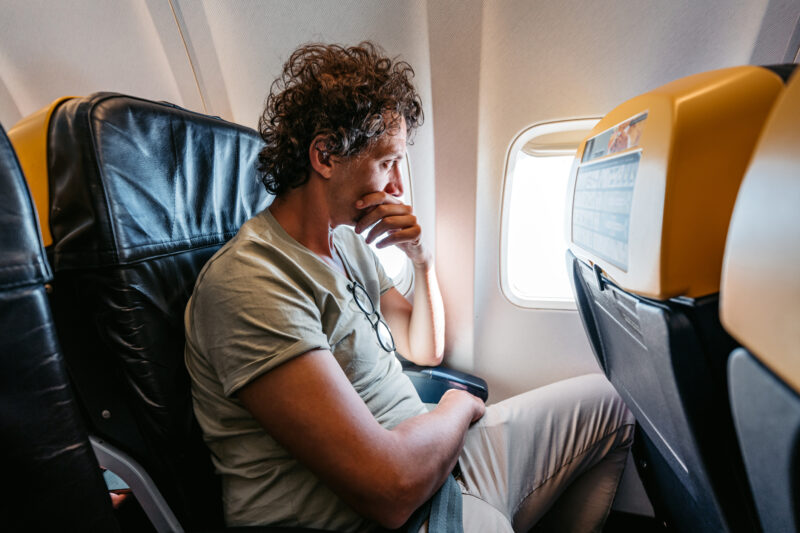
How Safe is Flying?
3 min.
Worried about turbulence or a plane crash? The truth is, commercial air travel is one of the safest ways to get around. Here’s what makes flying so secure.
Flying is one of the safest ways to travel, yet many people still have concerns about aviation safety. From turbulence and mechanical failures to aviation accidents and security risks, passengers often wonder how safe it really is to board a commercial plane. This article breaks down the facts, compares risks, and provides aviation expert-backed insights into flight safety.

Expert support for managing flight anxiety
Virtual therapy and effective tools to support your well-being.
What makes flying safe?
Flying is a highly regulated and technologically advanced form of travel. Several key factors ensure passenger safety:
Aircraft engineering & maintenance
Modern commercial planes are built with multiple safety redundancies, including backup systems for navigation, hydraulics, and power. Airlines conduct regular maintenance checks to prevent aviation incidents and mechanical failures.
Airline pilot training & regulations
Airline pilots undergo thousands of hours of training, simulator exercises, and routine evaluations to handle a wide range of scenarios, ensuring aviation safety at all times.
Air traffic control & safety protocols
Advanced air traffic controller systems monitor flights in real-time, ensuring safe takeoffs, landings, and mid-air navigation. Regulations from agencies like the federal aviation administration (FAA) and international civil aviation organization (ICAO) set global flight safety standards.
How safe is air travel compared to other forms of transportation?
Commercial air travel is statistically one of the safest modes of transportation, with a rate of 0.01 deaths per 100 million passenger miles traveled in airplanes. By contrast, train travel has a fatality rate of about 0.05 deaths per 100 million passenger miles on buses and trains, and car travel has an even higher fatality rate—0.72 deaths per 100 million passenger miles in cars.
Despite fears of a fatal accident involving a plane crash, the risk of dying in a car accident is significantly higher than in a commercial flight. News coverage of aviation accidents and airline incidents contributes to fear, but actual data shows that flying remains far safer than driving, biking, or even walking.
Why do people worry about flying?
While flying is statistically safe, certain factors contribute to fear and anxiety:
1. Turbulence fears
Turbulence is a common occurrence caused by changes in air pressure and weather conditions. While it may feel unsettling, modern aircraft are designed to withstand extreme turbulence.
2. Mechanical failures
While rare, mechanical issues are mitigated by pre-flight inspections, backup systems, and highly trained flight crew who can handle emergency situations.
3. Fear of crashes
Despite this common fear, commercial airline crashes are extremely rare, as substantiated by the data above.
4. Health concerns
Here are some common health concerns related to travel:
- Cabin air quality: While airplanes are a closed environment, most use HEPA filters, removing 99.9% of airborne contaminants and making cabin air safer than many indoor environments.
- Deep vein thrombosis (DVT): Long flights increase the risk of blood clots, but simple measures like walking around, staying hydrated, and wearing compression socks can help.
- Germ exposure: While airports and planes expose passengers to bacteria, frequent hand washing and sanitizing reduce infection risks.
When should you avoid flying?
For most travelers, commercial air travel is safe, but some medical conditions may require caution:
- Recent surgeries: Air pressure changes can affect post-surgical healing.
- Respiratory conditions: Individuals with severe asthma or chronic obstructive pulmonary disease (COPD) should consult a family physician before flying.
- Pregnancy: Most airlines allow travel up to 36 weeks of pregnancy, but high-risk pregnancies may require clearance from a doctor.
How to make flying safer & more comfortable
While flying is already safe, the following strategies can enhance flight safety and comfort:
- Deep breathing exercises, noise-canceling headphones, and understanding flight mechanics can reduce anxiety
- Staying hydrated, moving regularly, and boosting immunity with vitamins help prevent travel-related illnesses
- Passengers prone to motion sickness should choose seats over the wings for stability
- Flight attendants and airline pilots provide crucial safety instructions during passenger boarding and throughout the flight
How Charlie Health can help
If flight anxiety is affecting your mental health, Charlie Health is here to help. Charlie Health’s virtual Intensive Outpatient Program (IOP) provides mental health treatment for people dealing with serious mental health conditions, including anxiety, depression, trauma, and more. Our expert clinicians incorporate evidence-based therapies into individual counseling, family therapy, and group sessions. With this kind of holistic online therapy, managing your mental health is possible. Fill out the form below or give us a call to start healing today.

